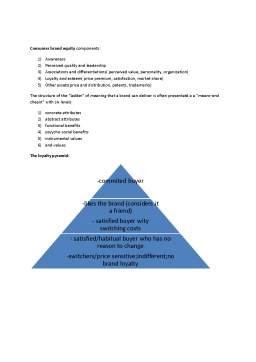Extras din notiță
Chapter 1
Integrated Communication
The integration of the various instruments of the marketing mix is one of the major principles of sound marketing strategy.
Marketing is the process of planning and executing the conception, pricing, promotion and distribution of ideas, goods and services to create and exchange value, and satisfy individual and organizational objectives.
The traditional marketing mix: 4 P’s
1) Product tool consists of three layers: the core product, the tangible product and the augmented product.
The core product is the unique benefit that is being marketed. In fact it’s the position, the unique place in the mind of the consumer, that will be focused upon.
The brand is often a summary, a visualization of this core benefit and all the associations it leads to.
The tangible product is what the core product is translated into. The instruments by which the core benefit can be made tangible are: product features, a certain level of quality, the available options, design and packaging.
The augmented product gives the tangible product more value and more customer appeal. The augmented product can be defined as the “service layer” on top of the tangible product. It includes elements such as prompt delivery, installation, service, after-sale service and management of complaints.
2) Price is the only marketing instrument that does not cost anything, but provides the resources to spend on production and marketing activity. The list price is the “official” price of the product. However, discounts and incentives of all kinds can be used to make the prod more attractive. Systems of down payments and payment periods, combined with attractive interest rates, can also be used to make the offering more attractive and ensure that the immediate budget constraint is less of a problem for the consumer.
The price tool is an ambiguous tool. On the one hand, price cuts are an effective way attract customers. On the other, they mean losing margin and profit . Furthermore the customer gets used to discounts and may gradually be educated to buy on price and be a brand-switcher.
The regular use of this tool is incompatible with building a strong position and a strong brand on the basis f product characteristics and benefits.
Good marketing can be defined as avoiding the price tool as much as possible.
3) By means of Place and Distribution the company manages the process of bringing the product from the production site to the customer. It involves : transporting the product, keeping an inventory, selecting wholesalers and retailers, deciding on which type of outlet the prod will be distributed in , and the assortment of products to be offered in various outlets.
Distribution strategy also implies maintaining co-operation between the company and the distribution channel, and finding new ways to distribute the products such as infomercials ( programme-length advertising and selling) and e-commerce.
4) Promotion or Marketing Communications (MC) are the most visible instruments in the marketing mix. They involve all instruments by means of which the company communicates with its target groups and stakeholders to promote its products or the company as a whole.
Good marketing= integrated marketing. Two principles are important when designing and implementing a marketing mix: interaction and synergy.
Synergy: marketing instruments have to be combined in such a way the company’s offering is consistently marketed. All the instruments have to work together in the same direction and not conflict with each other.
Interaction: the instruments have to be designed in such a way that the effects of the tools are mutually reinforcing.
The communications mix
Advertising= synonym of marketing communications because it’s the most visible tool of the communications mix (CM). But there are is a large variety of comm tools :
Advertising: non personal mass comm using mass media, the content of which is determined and paid for by a clearly identified sender ( the company)
Sales promotions: sales-stimulating campaigns ( price cuts, couponing, loyalty programmes, competitions, free samples, etc)
Sponsorship: the sponsor provides goods, funds, services and/or know-how. The sponsored company will help the sponsor with comm objectives.
Preview document
Conținut arhivă zip
- Marketing Communications - A European Perspective Summary.docx










































